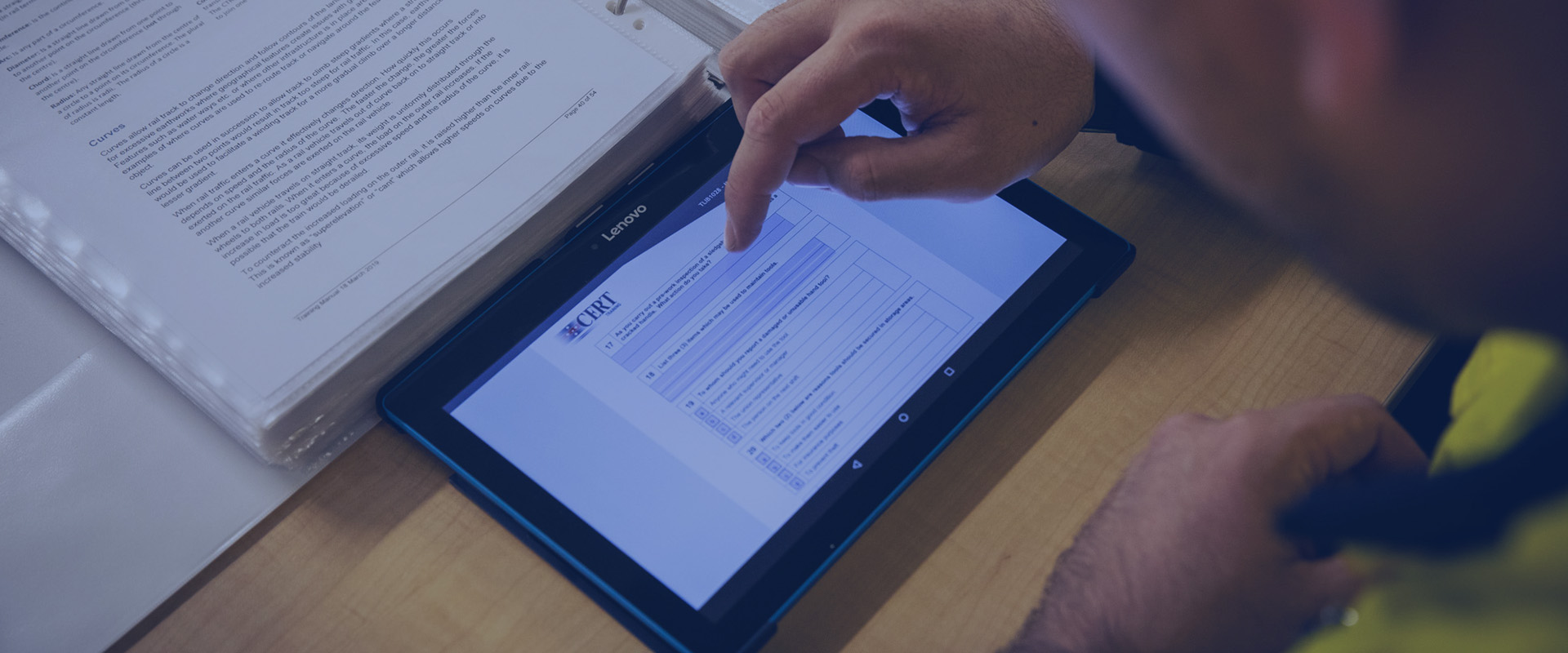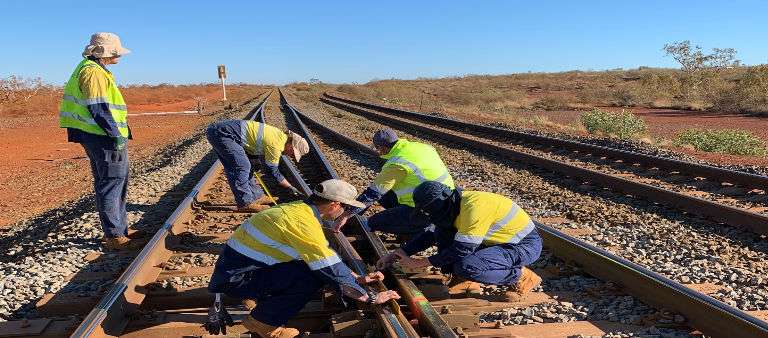
CERTIFICATE II IN RAIL INFRASTRUCTURE – WHAT YOU NEED TO KNOW
WHAT IS A CERTIFICATE II IN RAIL INFRASTRUCTURE COURSE?
The TLI21315 – Certificate II in Rail Infrastructure course is a general qualification for personnel engaged in basic operations within the rail infrastructure environment undertaking a range of tasks involving known routines and procedures and taking some responsibility for the quality of work outcomes. TLI21315 – Certificate II in Rail Infrastructure is a nationally recognised qualification and is suitable if you are new to rail.
Rail infrastructure is inclusive of the following:
- track supports and structures
- over or under track structures, including
- track,
- sleepers,
- foundation forming the track bed,
- cuttings,
- earthworks,
- drainage works,
- bridges and
- tunnels
- the electrical power supply system, including:
- feeders,
- switchgear and
- substations;
- any structure or equipment associated with any signalling, control or communications system including
- signalling boxes,
- huts,
- gantries,
- masts,
- towers,
- poles and
- frames
- station buildings and platforms,
- installations or equipment for lighting platforms or other parts of any station, yards or sidings;
- information boards and seating;
- warning, directional or other signs; shelters and furniture, including:
- buildings associated with the operation and maintenance of the track, such as
- stations,
- depots,
- yards,
- maintenance sheds
- refuelling facilities
- wash bay facilities.
- buildings associated with the operation and maintenance of the track, such as
TLI21315 Certificate II in Rail Infrastructure qualification comprises a total of 16 Units of Competency. The following information relates to CERT WA. For other state specific courses, please contact the CERT office relevant to you. CERT WA frequently offers the course tailored to those with existing experience or those new to the rail industry. This course specifically addresses knowledge and skill components relevant to a range of track maintenance and construction activities.
The key learning areas of the course cover the skills and knowledge relevant to:
- workplace health and safety,
- environmental procedures,
- effective communication techniques,
- appropriate manual handling techniques,
- fatigue management,
- rail safeworking requirements.
Other key learning areas of the course (dependent on special elective unit selection) may include the skills and knowledge relevant to the:
- installation of railway infrastructure,
- operation of minor mechanical equipment,
- completion of measurements and calculations,
- interpretation of plans and job specifications,
- awareness and routine maintenance of structures,
- equipment capability assessment,
- completion of track ballasting,
- measurement and recording of track geometry,
- operation of light, medium and/or heavy on-track equipment.
WHY DO I NEED TO COMPLETE A CERTIFICATE II IN RAIL INFRASTRUCTURE COURSE?
For many rail networks, you are required to have a minimum entry level standard of training. For those individuals not already employed within the rail industry, this qualification may assist your prospects of gaining employment.
Depending on which network you are or become employed within, you may be required to hold a Rail Industry Worker (RIW) card. This is an online program that gives participating organisations full visibility to a single electronic record of a workers competencies, health and education records as they move between employers or rail projects. Your primary employer must be in the RIW system and must order your RIW card (both physical and virtual).
To find out the requirements for each employment role within a rail network, you can visit the RIW website and find the matrix which describes the National Units of Competency you must hold to move into different employment roles.
WHY SHOULD I CHOOSE CERT TRAINING?
CERT Training is a Network Operator Approved Registered Training Organisation (RTO) on the Rail Industry Worker (RIW) website. Nationally, CERT employs in excess of thirty-five trainers and assessors with either a safety or rail background, and in most cases both. All CERT trainers have a minimum of ten year’s rail experience (most have in excess of twenty years) and two years training experience. Trainers have recent and ongoing experience in the delivery of rail infrastructure, rail operations and/or rail safeworking training and assessment. You can read more about CERT trainer/assessors here.
WHAT INDUSTRY ROLES DOES THIS RELATE TOO?
Job roles and titles vary across different sectors. Possible job titles relevant to this qualification include:
- Rail Infrastructure Track Work –
- track worker
- track installer
- track maintainer
- Rail infrastructure Structures –
- structures maintainer
- Rail Infrastructure Track Surfacing –
- plant operator
- mobile plant operator
- way gang driver.
WHERE CAN I DO THIS COURSE?
This course can be completed at CERT Training Centres in:
- Welshpool,
- Port Hedland or
- Bunbury.
If a company has several staff that require Certificate II in Rail Infrastructure qualification or individual Units of Competency, training may be offered at your premises anywhere in Western Australia, providing it meets relevant criteria. Extra charges may apply and you should contact CERT Western Australia for more details.
Other CERT offices in Australia also provide this qualification. For information, price and availability, please contact your local CERT office.
HOW AM I ASSESSED?
The training for this course has two components.
1. Classroom based learning which is delivered in English and assessed through a theory component comprised of multiple choice and short answer questions,
2. Practical learning conducted in a rail-based environment such as on-track, through which the tasks associated with working in the rail infrastructure environment are learned and then assessed using a Performance Assessment where you demonstrate the knowledge and skills gained throughout the training.
Prior to the commencement of training, all students are required to complete a Language, Literacy and Numeracy (LL&N) assessment. This assessment process ensures students have the best opportunity to complete training and undergo assessment, as well as apply the areas of competence successfully in the workplace. All CERT Trainers are skilled and experienced in dealing with students that may have language, literacy and numeracy issues and are qualified to tailor training and assessment strategies to the needs of the student.
In some cases, existing skills and knowledge relevant to your work role may be recognised to contribute to your course completion. Recognition of Prior Learning (RPL) is an assessment process that assesses the individual students formal, non-formal and informal learning and other experience to determine the extent to which that individual has achieved the competency standards of a course they are enrolled in. This can greatly reduce the time taken to demonstrate course and assessment requirements.
WHAT CAN I DO NEXT?
Upon successful completion of this course, learners are eligible to enrol in TLI32515 Certificate III in Rail Infrastructure – Core Units. This course allows you to further specialise in areas related to track infrastructure work.
WHEN CAN I COMPLETE THIS COURSE?
For more information on this course and to view prices and locations click here.

